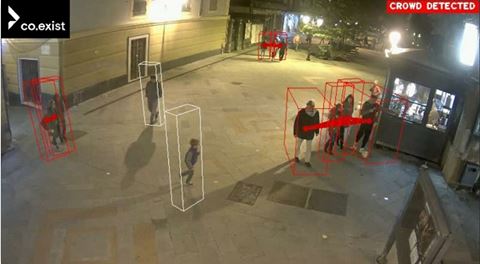At a time when nations are starting to lift COVID -19 lockdown restrictions, there are places when people are risking the spread of the virus by, deliberately or even perhaps unknowingly, flaunting the crucial social distancing guidelines, particularly in parks, shops, airports and other public spaces. In this article Roy Band, EMEA Community Manager, at Milestone Systems, claims that open platform VMS could provide all the necessary features and functionality a user would need, combined with the ability to integrate any technology to assist with this important issue.
As nations have started to lift Covid-19 lockdown restrictions, large crowds of people have flocked to parks to enjoy spring temperatures but risking social-distancing guidelines that are deemed crucial to prevent an uncontrollable spread of virus.
In parallel, shops are asked to ensure a safe reopening in adherence with the requirements coming from health authorities, e.g. that people need to maintain a social distance of at least one meter.
Typically, governments and organizations are faced with the following challenges:
• Which part of my city, shop or premises are most crowded and when?
• How do I make sure my building or shop doesn’t get over-crowded?
• How do I know when people are getting too close to each other?
• How do I address people and avoid confrontation or incidents at the entrance to a store?
Using video to maintain safe distances
An open platform VMS provides all the necessary features and functionality a user would need, combined with the ability to integrate any technology to assist with the process of social distancing. These video solutions involve a four-stage process of firstly establishing awareness of a situation, then confirming that distances are being maintained, responding to unsafe behaviour and analysing data to identify areas and activities that are proving problematic.
Here are a few examples of how video technology can contribute to a safe reopening of societies:
1. Heatmap and occupancy statistics (historical)
With the power of video, we can identify the areas in a shop, premise or in a city which typically have the highest occupancy rates. This can be done by creating heatmaps or occupancy statistics based on the images the cameras have captured. Intelligent video analytics solutions can provide this information historically or in real-time. In this way, it is easy to see where to deploy preventive measures like dispatching enforcement personnel, mounting digital signs or creating audio notifications with PA systems.
2. Crowd counting solutions
There is a danger of a fallback when COVID-19 restrictions are gradually being relaxed. So, in city squares, beaches, tourist attractions or other popular public places, social distance needs to be maintained for a longer period. Crowd counting solutions based on video analytics can help alert authorities to when these places get too crowded and social distance is at jeopardy. These alerts will be received in real-time, and historical statistics will also be available.
3. Responding to crowding
Dispatching personnel to deal with unsafe distancing and risky behaviour places these people at risk from infection, and they may face verbal or physical harassment. If they have to be deployed, however, video can support them with rules-based push notifications that send them to the place where an incident is taking place, giving them control of all the doors needed to access the area from their smartphone, and integrating with body worn video if being used.
4. Keeping people notified
Both audio and visual messaging can be integrated with video, so those on a station platform can be given an audio reminder to maintain a safe distance over a PA system automatically when video identifies bunching. Screens can automatically provide notices of alternative access to buildings based on if the video system detects crowding in a particular area.
5. Allowing touch-free access to buildings
VMS makes the integration of video with access control simple and allows people to access their workplaces without touching doorknobs, handles and card or fingerprint readers. This is important says Band “as studies suggest that the COVID-19 virus can survive up to 72 hours on stainless steel and plastics.” These systems rely on electronic motorised door opening systems and either facial recognition of those seeking to gain entry, or a simple QR code scanned from a smartphone.
6. Detecting facial masks
Authorities are currently considering how facial recognition can be incorporated into contact tracing apps or to augment digital ‘health passports’ that might allow freer movement of those how are uninfected. This same technology can also be used to detect face masks or protective eyewear in areas where this personal protective equipment is required.
7. Ensuring privacy
Clearly there is a need to balance privacy and the need to contain the pandemic. However, the video solutions outlined here can be used in total compliance with GDPR, which governs data protection, data processing and privacy. What’s more, the addition of a ‘Copenhagen Clause’ in Milestone’s end user license agreement insists that its technology is used in a way that respects the Copenhagen Letter, a 2017 initiative that seeks to put people back in control of technology and which calls for those that develop and use it to do so in a responsible way.
Roy Band,
EMEA Community Manager, at Milestone Systems


